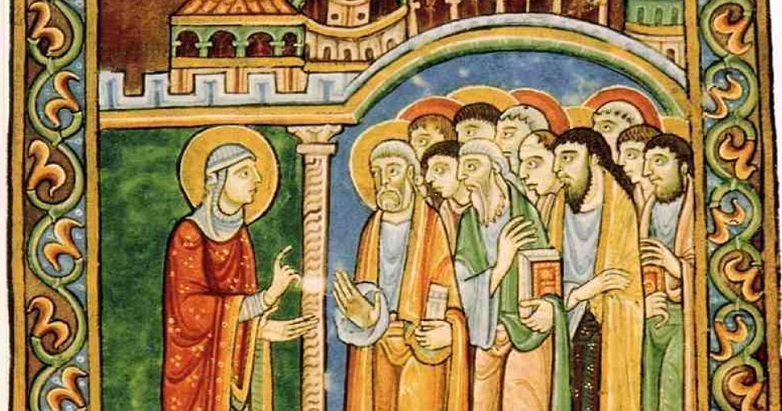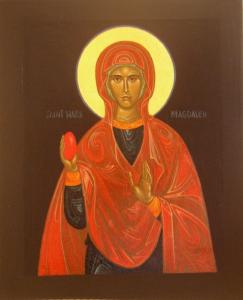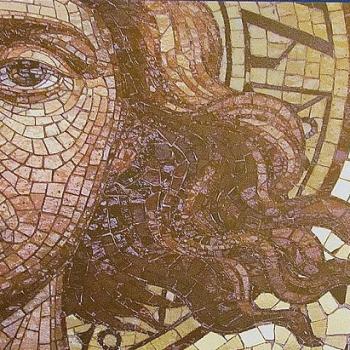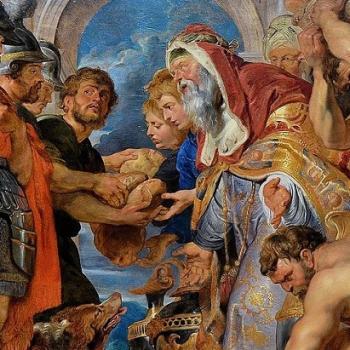
Why did Jesus choose Mary Magdalene to be the first preacher of the Gospel, the “good news” of his resurrection? Shouldn’t he have chosen either Peter – “the rock” (Matt 16:18) – or John, who both ran eagerly to his tomb (John 20:3)? Much has been made of the fact that a woman’s witness at the time would have counted very little, which conversely makes the resurrection story more believable; if Jesus’ followers had been trying to fake his resurrection, they surely wouldn’t have chosen a woman as their first witness! Yet, if we consider the Gospel account and its parallels to Genesis, we see richer, alternative meanings emerge for Mary Magdalene’s key role here.
Eve is the first to sin, eating from the tree of life and sharing its forbidden fruit with Adam. As a result of their sin, death ensues, and God gives Eve some specific bad news: man shall rule over her (Gen. 3:16).
Mary Magdalene is first to see and eat of the new tree of life: Jesus. She shares the fruit of the tree, the life-giving truth of Jesus’ resurrection, with her brothers, as the first preacher of the “good news.” As a typology for Eve, Mary’s preeminence here in relation to the 12 male disciples is no accident but a symbolic unraveling of the Fall – and of its consequences – that Jesus accomplishes on the cross.
Reversing Sin
In the garden, after the Fall, God warns Eve that because she ate the forbidden fruit, she will have to contend with male supremacy. God then banishes Eve (and Adam) from Eden, placing an angel at the entrance to guard the way to the tree of life (3:22-24). Eve makes her way out of the garden, perhaps hanging her head, subject to her husband, wondering when the curse will be broken.
Thousands of years later, Mary, hanging her head, makes her way to Jesus’ tomb with burial spices. The tomb, like Eden, is guarded by an angel, and must itself be within a garden, for when Mary first sees Jesus there, she mistakes him for the gardener (John 20:15). She expects to find his decaying body but instead encounters the living Christ – the tree of life – and tastes the sweet fruit of his resurrection. The idea of Christ the apple tree is beautifully conveyed in a poem by Rev. Richard Hutchins:
“I’ll sit and eat this fruit divine,
It cheers my heart like spirit’al wine;
And now this fruit is sweet to me,
That grows on Christ the Appletree.”
In a dramatic narrative reversal to the Fall, Mary eats of the life-giving fruit of Jesus, the tree of life, then shares the fruit of the tree with her brothers, the other disciples. They taste and see for themselves the risen Christ, the tree of life. The Fall is symbolically undone.
Reversing Male Supremacy
I wonder if the angel responsible for blocking our access to Eden was the same angel God tapped to announce the good news to Mary about Jesus – the good news that the way back to Eden has been opened! The angel tells Mary: “He has risen! He is not here. See the place where they laid him. But go, tell his disciples and Peter” (Mark 16:6-7). In John’s narrative, Jesus himself implores Mary to share the good news with the disciples. (John 20: 17).
Ironically, in those times, a woman’s witness was legally inferior to a man’s, but this important point leads us to the second reason why God chose a woman for this (man’s) job.
While the “good news” doesn’t spell the immediate end of sin and suffering, it promises eternal life in a world where sin and its consequences will be eradicated. God’s bad news to Eve – just after the Fall – that her sin will subject her to the rule of man, shall be utterly undone in the kingdom to come. But God’s “kingdom come” is supposed to start now.
So perhaps it should not surprise us that just after the resurrection of Jesus, we see the glimmer of the end of male supremacy: a reenactment of the Fall in reverse.
It can’t be insignificant that Jesus’ very first act, post-Resurrection, involves repudiating patriarchal norms. He does that by raising Mary to an unusual position of privilege in relation to men, as a preeminent witness and preacher to them: the Apostle to the apostles. Importantly, Jesus’ repudiation of male supremacy post-Resurrection arises in parallel contrast to God’s announcement of male supremacy post-Fall.
Two short asides:
- Jesus isn’t denigrating men’s leadership here; rather, his actions suggest that gender hierarchies of power, wrought in the Fall, have no place in the Kingdom he has ushered in. By elevating Mary as a preacher to the 12, Jesus symbolically cancels the gender hierarchy created by sin, even as his death cancels sin.
- Advocates of “male headship” argue that women and men are ontologically equal, or equal in being, but that women are functionally subordinate. While this concept is arguably based on a dubious interpretative approach to, and understanding of, several Biblical passages, it’s beset by a more fundamental problem: cognitive error. If the functional subordination of women is itself based on sex, and sex is fundamental to our being, or ontology, the subordination isn’t merely functional but ontological! Under “male headship” there is thus no equality of the sexes, functional or ontological, only a false claim, or pretense to equality. The fallacy of equality under “male headship” is easily exposed by a bit of critical thinking before we even get to Scripture, where the resurrected Jesus rejects this idea. Indeed, via Mary Magdalene, the risen Christ symbolically reinstates woman as man’s ontological and functional equal. His actions belie the bifurcation of equality assumed by “male headship.”
Re-imagining Mary Magdalene

In traditional Christian iconography, Mary Magdalene is often depicted holding a red egg. Although the egg refers to a miracle of legend, it broadly signifies her pivotal role as a Gospel witness.
Mary’s divine appointment as the first preacher and witness – to men – of the risen Christ, the tree of life, symbolically reinstates Eve, who led Adam into death by sharing with him the fruit of the forbidden tree. This reversal represents not just an undoing of Eve’s sin, ultimately accomplished by Christ, but a reversal of sin’s consequences for women, as woman is symbolically restored to her original, Edenic status as man’s equal.
Perhaps gazing at this icon, we can prayerfully contemplate an apple in place of an egg.
Implications for the Church: Some Questions
Jesus made Mary Magdalene the preeminent witness of his resurrection, the Apostle to the apostles. In doing so, he elevated her to a role typically reserved for men. In fact, he does the same thing to Mary at Martha’s table, praising her for “sitting at his feet” with the same verbiage used to describe a male student studying under a rabbi. When Mary anoints Jesus with perfume, she again takes on the role of the Jewish male priests, who were responsible for anointing Israel’s kings.
How many times does Jesus have to elevate Mary to traditionally privileged “male” roles before we get the point?
Advocating “male headship” as God’s intent for humanity is totally out of sync with what Jesus actually does with women, particularly Mary Magdalene. However, if “male headship” is a consequence of the Fall and part of our fallen world, Jesus’ actions make perfect sense because he died to destroy that world, as he ushers in a new world where “male headship” has no place.
As a church, how are we following Jesus here? How are we preparing for this new world now?
We might consider the following questions:
- Are we promoting competent women to positions of leadership, on par with men? Or are we finding “justifications” to exclude women from certain roles based on their sex?
- Are we highlighting, or are we challenging, scholarship that sews prejudice and promotes the gendered roles Jesus subtly opposed?
- Are we using Bible translations that accurately reflect the presence of women, or are we using translations that falsely obscure women?
- Are we allowing Jesus’ rather radical actions toward women, and their implications, properly shape our translation principles, our hermeneutic/interpretive approach, and our exegesis/interpretation?
- Of course, Jesus did not abolish male supremacy any more than he abolished slavery; but on both points, where do his actions lead us?
- How do Jesus’ actions reflect on the desire of many evangelicals and Catholics to create and/or maintain a gender hierarchy in the church?
There are a few Gospel passages that allegedly support women’s subordination. But what happens when you look at those passages with an interpretive lens whose aperture is widened by appreciation of 1) the various ways Jesus challenged gender hierarchies; 2) other contrary passages in Scripture; and 3) competent scholarship arguing for different interpretations of those passages based on textual and situational nuances? Suddenly those passages that “obviously” support male headship suddenly don’t.
Ultimately, Jesus’ resurrection is not just about him; it’s about us. And it’s not just about us being raised with perfected bodies, but with perfected relationships in which the cleavage between man and woman, created in the Fall, is un-created.
Are we working with Jesus to “un-create” those cleavages? Or are we working against Jesus to institutionalize them?














